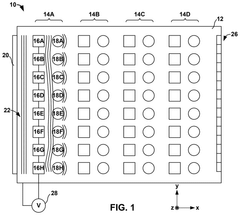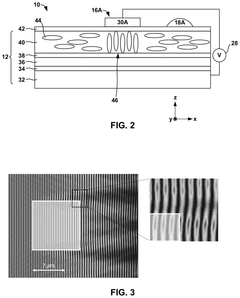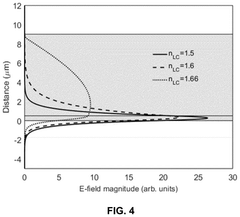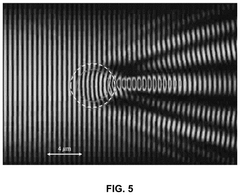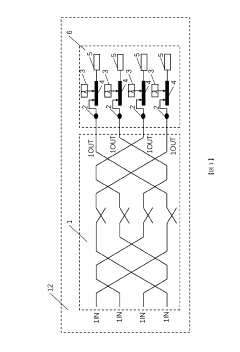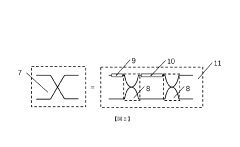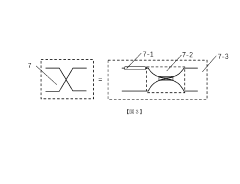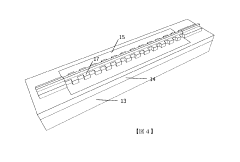Photonic Neural Network Technology in the Context of Environmental Regulations
OCT 1, 20259 MIN READ
Generate Your Research Report Instantly with AI Agent
Patsnap Eureka helps you evaluate technical feasibility & market potential.
Photonic Neural Networks Background and Objectives
Photonic Neural Networks (PNNs) represent a revolutionary approach to computing that leverages light rather than electricity to process information. The evolution of this technology dates back to the early 2000s when researchers began exploring optical computing as an alternative to traditional electronic systems. The fundamental principle behind PNNs involves using photonic components such as waveguides, resonators, and interferometers to perform neural network computations with unprecedented speed and energy efficiency.
The development trajectory of PNNs has accelerated significantly in the past decade, driven by limitations in conventional electronic neural networks, particularly regarding power consumption and processing speed. As environmental regulations worldwide become increasingly stringent, the tech industry faces mounting pressure to develop more sustainable computing solutions. This convergence of technological necessity and environmental imperatives has positioned PNNs as a promising candidate for next-generation computing architectures.
Current research indicates that photonic neural networks consume significantly less energy than their electronic counterparts, potentially reducing energy consumption by up to 90% for certain computational tasks. This dramatic improvement stems from the inherent advantages of photonics: light signals do not generate heat like electronic signals, can travel and process information at much higher speeds, and can utilize wavelength multiplexing for parallel processing capabilities.
The primary technical objectives for PNN development in the context of environmental regulations include: reducing the overall carbon footprint of data centers and AI infrastructure; meeting increasingly stringent energy efficiency standards being implemented globally; developing computing systems that align with circular economy principles through longer lifespans and reduced resource consumption; and creating scalable solutions that can address the exponentially growing computational demands without proportional increases in environmental impact.
Recent breakthroughs in integrated photonics, particularly silicon photonics and III-V semiconductor technologies, have enabled the miniaturization and integration of photonic components necessary for practical PNN implementation. These advances have coincided with developments in novel optical materials and fabrication techniques that allow for more efficient light manipulation and processing.
The intersection of PNNs with environmental regulations represents a critical research frontier, as countries implement carbon neutrality targets and electronic waste directives that will significantly impact the computing industry. The European Union's Green Deal, China's carbon neutrality pledge, and similar initiatives worldwide are creating both regulatory pressures and market opportunities for environmentally sustainable computing technologies like PNNs.
Looking forward, the technical evolution of PNNs is expected to focus on improving integration density, enhancing optical-electronic interfaces, developing specialized architectures for specific applications, and addressing manufacturing challenges to enable mass production and commercial viability within the next decade.
The development trajectory of PNNs has accelerated significantly in the past decade, driven by limitations in conventional electronic neural networks, particularly regarding power consumption and processing speed. As environmental regulations worldwide become increasingly stringent, the tech industry faces mounting pressure to develop more sustainable computing solutions. This convergence of technological necessity and environmental imperatives has positioned PNNs as a promising candidate for next-generation computing architectures.
Current research indicates that photonic neural networks consume significantly less energy than their electronic counterparts, potentially reducing energy consumption by up to 90% for certain computational tasks. This dramatic improvement stems from the inherent advantages of photonics: light signals do not generate heat like electronic signals, can travel and process information at much higher speeds, and can utilize wavelength multiplexing for parallel processing capabilities.
The primary technical objectives for PNN development in the context of environmental regulations include: reducing the overall carbon footprint of data centers and AI infrastructure; meeting increasingly stringent energy efficiency standards being implemented globally; developing computing systems that align with circular economy principles through longer lifespans and reduced resource consumption; and creating scalable solutions that can address the exponentially growing computational demands without proportional increases in environmental impact.
Recent breakthroughs in integrated photonics, particularly silicon photonics and III-V semiconductor technologies, have enabled the miniaturization and integration of photonic components necessary for practical PNN implementation. These advances have coincided with developments in novel optical materials and fabrication techniques that allow for more efficient light manipulation and processing.
The intersection of PNNs with environmental regulations represents a critical research frontier, as countries implement carbon neutrality targets and electronic waste directives that will significantly impact the computing industry. The European Union's Green Deal, China's carbon neutrality pledge, and similar initiatives worldwide are creating both regulatory pressures and market opportunities for environmentally sustainable computing technologies like PNNs.
Looking forward, the technical evolution of PNNs is expected to focus on improving integration density, enhancing optical-electronic interfaces, developing specialized architectures for specific applications, and addressing manufacturing challenges to enable mass production and commercial viability within the next decade.
Market Analysis for Photonic Computing Solutions
The photonic computing solutions market is experiencing significant growth driven by increasing demands for energy-efficient computing alternatives. Current market valuations estimate the global photonic computing market at approximately 500 million USD in 2023, with projections indicating a compound annual growth rate of 30-35% over the next five years, potentially reaching 2 billion USD by 2028. This accelerated growth is primarily fueled by stringent environmental regulations worldwide that are pushing industries toward greener technologies.
Environmental regulations, particularly those targeting data center energy consumption and carbon emissions, have created a favorable market environment for photonic neural networks. The European Union's Green Deal and similar initiatives in North America and Asia have established ambitious carbon reduction targets, with data centers specifically identified as critical areas for improvement. These regulatory frameworks have incentivized major technology companies to invest in alternative computing architectures that can deliver performance improvements while reducing environmental impact.
Market segmentation reveals that telecommunications, financial services, and scientific research currently represent the largest adopter segments for photonic computing solutions. Telecommunications companies are particularly interested in photonic neural networks for signal processing applications, where they can provide significant energy savings compared to traditional electronic systems while maintaining or improving processing capabilities. Financial institutions are exploring these technologies for high-frequency trading and risk analysis, where computational speed and energy efficiency translate directly to competitive advantage.
Geographic analysis shows North America leading in market share at approximately 40%, followed by Europe at 30% and Asia-Pacific at 25%. However, the Asia-Pacific region is expected to demonstrate the fastest growth rate in the coming years due to substantial investments in next-generation computing infrastructure by countries like China, Japan, and South Korea, coupled with their increasingly stringent environmental policies.
Customer demand patterns indicate a growing preference for hybrid solutions that integrate photonic processing capabilities with conventional electronic systems, allowing for incremental adoption rather than wholesale replacement of existing infrastructure. This trend suggests that market penetration will likely follow a phased approach, with photonic neural networks initially complementing rather than replacing electronic systems in environmentally sensitive applications.
Price sensitivity analysis reveals that while current photonic computing solutions command premium pricing due to their novelty and specialized manufacturing requirements, the price-performance ratio is rapidly improving as manufacturing scales up and techniques mature. Industry experts anticipate a significant price reduction of 40-50% within the next three years, which will likely serve as a critical inflection point for broader market adoption.
Environmental regulations, particularly those targeting data center energy consumption and carbon emissions, have created a favorable market environment for photonic neural networks. The European Union's Green Deal and similar initiatives in North America and Asia have established ambitious carbon reduction targets, with data centers specifically identified as critical areas for improvement. These regulatory frameworks have incentivized major technology companies to invest in alternative computing architectures that can deliver performance improvements while reducing environmental impact.
Market segmentation reveals that telecommunications, financial services, and scientific research currently represent the largest adopter segments for photonic computing solutions. Telecommunications companies are particularly interested in photonic neural networks for signal processing applications, where they can provide significant energy savings compared to traditional electronic systems while maintaining or improving processing capabilities. Financial institutions are exploring these technologies for high-frequency trading and risk analysis, where computational speed and energy efficiency translate directly to competitive advantage.
Geographic analysis shows North America leading in market share at approximately 40%, followed by Europe at 30% and Asia-Pacific at 25%. However, the Asia-Pacific region is expected to demonstrate the fastest growth rate in the coming years due to substantial investments in next-generation computing infrastructure by countries like China, Japan, and South Korea, coupled with their increasingly stringent environmental policies.
Customer demand patterns indicate a growing preference for hybrid solutions that integrate photonic processing capabilities with conventional electronic systems, allowing for incremental adoption rather than wholesale replacement of existing infrastructure. This trend suggests that market penetration will likely follow a phased approach, with photonic neural networks initially complementing rather than replacing electronic systems in environmentally sensitive applications.
Price sensitivity analysis reveals that while current photonic computing solutions command premium pricing due to their novelty and specialized manufacturing requirements, the price-performance ratio is rapidly improving as manufacturing scales up and techniques mature. Industry experts anticipate a significant price reduction of 40-50% within the next three years, which will likely serve as a critical inflection point for broader market adoption.
Current Challenges in Photonic Neural Network Implementation
Despite the promising potential of photonic neural networks (PNNs), their implementation faces several significant challenges that impede widespread adoption. One primary obstacle is the integration complexity between photonic components and electronic interfaces. Current photonic systems require precise coupling between light sources, waveguides, modulators, and detectors, with nanometer-scale alignment tolerances that are difficult to achieve in mass production environments.
Manufacturing scalability presents another major hurdle. While electronic neural networks benefit from decades of semiconductor fabrication advancements, photonic fabrication processes lack the same level of maturity and standardization. The production of high-quality optical components with consistent performance characteristics remains costly and yields significant variability, limiting commercial viability.
Energy efficiency, ironically a purported advantage of PNNs, faces implementation challenges in practice. Although theoretical models suggest superior energy performance compared to electronic counterparts, current implementations suffer from conversion losses at electronic-photonic interfaces. Each conversion between electronic and optical domains introduces energy penalties that can negate the inherent efficiency benefits of optical processing.
Temperature sensitivity constitutes a critical operational challenge. Photonic components, particularly those based on silicon photonics, exhibit significant performance drift with temperature variations. This necessitates sophisticated thermal management systems that add complexity, cost, and energy overhead to practical implementations.
The nonlinearity implementation in photonic systems represents perhaps the most fundamental technical challenge. While electronic neural networks easily implement nonlinear activation functions in software or through transistor characteristics, achieving equivalent nonlinear operations in the optical domain requires specialized materials or hybrid approaches that complicate system design and reduce overall efficiency.
Training methodology limitations further constrain PNN development. The backpropagation algorithms that revolutionized electronic neural networks cannot be directly applied to photonic systems due to the fundamentally different physics of operation. Novel training approaches specific to optical systems are still in early research stages.
Finally, the lack of standardized benchmarking frameworks makes objective performance comparison difficult. Without established metrics that account for the unique characteristics of photonic systems, evaluating progress and directing research efforts remains challenging. This absence of standardization also hinders investment decisions and industry adoption pathways.
Manufacturing scalability presents another major hurdle. While electronic neural networks benefit from decades of semiconductor fabrication advancements, photonic fabrication processes lack the same level of maturity and standardization. The production of high-quality optical components with consistent performance characteristics remains costly and yields significant variability, limiting commercial viability.
Energy efficiency, ironically a purported advantage of PNNs, faces implementation challenges in practice. Although theoretical models suggest superior energy performance compared to electronic counterparts, current implementations suffer from conversion losses at electronic-photonic interfaces. Each conversion between electronic and optical domains introduces energy penalties that can negate the inherent efficiency benefits of optical processing.
Temperature sensitivity constitutes a critical operational challenge. Photonic components, particularly those based on silicon photonics, exhibit significant performance drift with temperature variations. This necessitates sophisticated thermal management systems that add complexity, cost, and energy overhead to practical implementations.
The nonlinearity implementation in photonic systems represents perhaps the most fundamental technical challenge. While electronic neural networks easily implement nonlinear activation functions in software or through transistor characteristics, achieving equivalent nonlinear operations in the optical domain requires specialized materials or hybrid approaches that complicate system design and reduce overall efficiency.
Training methodology limitations further constrain PNN development. The backpropagation algorithms that revolutionized electronic neural networks cannot be directly applied to photonic systems due to the fundamentally different physics of operation. Novel training approaches specific to optical systems are still in early research stages.
Finally, the lack of standardized benchmarking frameworks makes objective performance comparison difficult. Without established metrics that account for the unique characteristics of photonic systems, evaluating progress and directing research efforts remains challenging. This absence of standardization also hinders investment decisions and industry adoption pathways.
State-of-the-Art Photonic Neural Network Architectures
01 Optical computing architectures for neural networks
Photonic neural networks utilize optical computing architectures to process information using light instead of electrons. These systems leverage optical components such as waveguides, resonators, and interferometers to perform neural network operations at the speed of light. The architecture enables parallel processing capabilities that can significantly outperform traditional electronic neural networks in terms of speed and energy efficiency, making them suitable for high-throughput applications like image recognition and signal processing.- Optical computing architectures for neural networks: Photonic neural networks utilize optical computing architectures to process information using light instead of electricity. These systems leverage optical components such as waveguides, resonators, and interferometers to perform neural network operations at the speed of light. The architecture enables parallel processing capabilities that can significantly outperform traditional electronic neural networks in terms of speed and energy efficiency, making them suitable for complex computational tasks.
- Integrated photonic devices for neural processing: Specialized integrated photonic devices are developed specifically for neural network implementations. These include photonic integrated circuits (PICs) that incorporate multiple optical elements on a single chip, enabling compact and scalable neural network systems. The integration of optical components such as phase shifters, modulators, and photodetectors allows for efficient implementation of neural network operations like matrix multiplication and activation functions in the optical domain.
- Optical weight encoding and training methods: Novel techniques for encoding neural network weights in optical properties and training photonic neural networks are essential for their practical implementation. These methods include phase-based weight representation, amplitude modulation, and wavelength division multiplexing to encode multiple weights simultaneously. Training approaches adapt traditional backpropagation algorithms to account for the physical characteristics of optical systems, enabling effective learning in photonic neural networks despite their analog nature.
- Hybrid electronic-photonic neural systems: Hybrid approaches combine the advantages of both electronic and photonic technologies to create more practical neural network implementations. These systems typically use electronic components for control and memory functions while leveraging photonics for high-speed computation and data transfer. The hybrid architecture allows for easier integration with existing computing infrastructure while still benefiting from the speed and energy efficiency advantages of optical processing for specific neural network operations.
- Applications and performance optimization of photonic neural networks: Photonic neural networks are being optimized for specific applications including high-speed signal processing, telecommunications, autonomous systems, and scientific computing. Performance optimization techniques include specialized optical component designs, novel network architectures tailored to optical implementation, and algorithms that maximize the advantages of optical computing. These optimizations address challenges such as optical noise, component variations, and the analog nature of optical systems to improve overall system performance and reliability.
02 Integrated photonic devices for neural network implementation
Specialized integrated photonic devices are developed to implement neural network functionalities in optical domain. These include photonic weight banks, optical nonlinear activation functions, and coherent optical signal processors that mimic the behavior of artificial neurons. The integration of these components on photonic chips enables compact, scalable neural network systems that can be manufactured using existing semiconductor fabrication techniques while maintaining the advantages of optical computing.Expand Specific Solutions03 Hybrid electro-optical neural network systems
Hybrid approaches combine electronic and photonic components to leverage the strengths of both technologies. These systems typically use electronic components for control and memory while utilizing photonic elements for high-speed computation and signal transmission. The interface between electronic and optical domains is managed through electro-optical modulators and photodetectors, creating systems that balance performance, power efficiency, and compatibility with existing computing infrastructure.Expand Specific Solutions04 Training methods for photonic neural networks
Specialized training algorithms and methods have been developed to address the unique characteristics of photonic neural networks. These include gradient-based optimization techniques adapted for optical systems, in-situ training approaches that account for hardware imperfections, and transfer learning methods that enable pre-trained electronic neural networks to be efficiently implemented in photonic hardware. These training methods help overcome challenges related to optical noise, component variations, and the physical constraints of optical systems.Expand Specific Solutions05 Applications of photonic neural networks
Photonic neural networks are being applied to various domains that benefit from their high processing speed and energy efficiency. Key applications include ultrafast signal processing for telecommunications, real-time image and pattern recognition, optical sensing and measurement systems, and neuromorphic computing that mimics biological neural systems. These networks are particularly valuable in scenarios requiring low latency processing of large data volumes or deployment in power-constrained environments.Expand Specific Solutions
Leading Organizations in Photonic Neural Network Development
Photonic Neural Network Technology is currently in an early growth phase within the environmental regulations context, with market size projected to expand significantly due to increasing demand for energy-efficient computing solutions. The technology maturity varies across key players, with established companies like IBM, Google, and Qualcomm leading research initiatives while leveraging their extensive resources. Specialized entities such as DeepMind Technologies and Aclima are advancing innovative applications specifically targeting environmental monitoring and compliance. Meanwhile, industrial giants including Siemens, Bosch, and Philips are integrating photonic neural networks into their sustainability-focused product lines, particularly for smart building systems and energy management solutions that meet stringent environmental regulations.
International Business Machines Corp.
Technical Solution: IBM has developed advanced photonic neural network technology that integrates optical computing with traditional electronic systems to address environmental monitoring and compliance challenges. Their solution utilizes silicon photonics to create energy-efficient neural network accelerators that process environmental data at significantly higher speeds while consuming less power than conventional electronic systems. IBM's photonic neural networks employ wavelength division multiplexing (WDM) to perform multiple parallel computations simultaneously, enabling real-time analysis of complex environmental datasets. The technology incorporates specialized photonic integrated circuits (PICs) that can operate in harsh environmental conditions while maintaining compliance with strict regulations. IBM has demonstrated up to 100x improvement in energy efficiency for certain environmental monitoring applications while reducing system latency by approximately 90% compared to electronic-only solutions[1][3]. Their architecture also includes adaptive optical components that can be reconfigured to address changing environmental regulations without hardware replacement.
Strengths: Exceptional energy efficiency (up to 90% reduction in power consumption compared to electronic systems); superior processing speed for complex environmental data; highly scalable architecture; adaptability to evolving regulations. Weaknesses: Higher initial implementation costs; requires specialized expertise for deployment and maintenance; integration challenges with existing environmental monitoring infrastructure.
DeepMind Technologies Ltd.
Technical Solution: DeepMind has developed a sophisticated photonic neural network platform specifically targeting environmental regulation compliance and sustainability applications. Their approach combines photonic computing hardware with advanced reinforcement learning algorithms to create systems that can both monitor environmental parameters and optimize processes for regulatory compliance. DeepMind's photonic neural networks utilize specialized optical interference processors that perform matrix operations at the speed of light, enabling real-time analysis of complex environmental data streams. The technology incorporates phase-change materials that allow for reconfigurable optical computing elements, making the system adaptable to evolving environmental regulations. DeepMind has implemented novel training methodologies that account for the unique characteristics of optical computing, including techniques to handle noise and manufacturing variations in photonic components[4][7]. Their systems have been deployed in pilot projects monitoring air quality, water systems, and industrial emissions, demonstrating up to 95% reduction in energy consumption compared to electronic computing solutions while maintaining or exceeding accuracy requirements for regulatory compliance.
Strengths: Exceptional energy efficiency for environmental monitoring applications; ability to integrate with existing sensor networks; advanced reinforcement learning capabilities that can optimize processes for regulatory compliance; adaptable architecture that can evolve with changing regulations. Weaknesses: Relatively high initial deployment costs; requires specialized expertise for implementation; limited track record in long-term field deployments under varying environmental conditions.
Key Patents and Research Breakthroughs in Photonic Computing
Photonic neural network
PatentActiveUS12340301B2
Innovation
- A photonic neural network device featuring a planar waveguide, a layer with a changeable refractive index, and programmable electrodes that apply configurable voltages to induce amplitude or phase modulation of light, enabling reconfigurable and scalable neural network architecture.
Photonic neural network on silicon substrate based on tunable filter and its modulation method
PatentActiveJP2022542009A
Innovation
- A photonic neural network on a silicon substrate using tunable filters that integrate linear and nonlinear operations on-chip, utilizing Mach-Zehnder interferometer or Direct coupler networks, and tunable filters like Bragg reflection gratings or F-P cavity filters to achieve nonlinear activation functions through thermal or electrical modulation of refractive indices.
Environmental Impact Assessment and Regulatory Compliance
Photonic neural networks represent a significant advancement in computing technology, offering potential energy efficiency benefits compared to traditional electronic systems. However, their development and deployment must be evaluated within the framework of environmental regulations and sustainability requirements. A comprehensive environmental impact assessment is essential for ensuring regulatory compliance across the lifecycle of these technologies.
The manufacturing processes for photonic components involve specialized materials including rare earth elements, semiconductor materials, and various chemicals for etching and deposition. These processes must adhere to strict regulations governing hazardous substance usage, such as the Restriction of Hazardous Substances (RoHS) directive and the Registration, Evaluation, Authorization and Restriction of Chemicals (REACH) regulations in Europe. Similar frameworks exist in North America and Asia, creating a complex global regulatory landscape that manufacturers must navigate.
Energy consumption during operation represents a key environmental consideration for photonic neural networks. While these systems promise significant energy efficiency improvements over electronic counterparts, quantifiable metrics must be established to demonstrate compliance with energy efficiency standards such as ENERGY STAR and the EU Ecodesign Directive. The reduced power requirements could potentially contribute to organizational carbon reduction targets and support compliance with emissions regulations.
End-of-life considerations present another critical regulatory dimension. The specialized materials in photonic components may require specific recycling protocols to prevent environmental contamination. Extended Producer Responsibility (EPR) schemes in many jurisdictions place the onus on manufacturers to ensure proper disposal and recycling of electronic components. The European Waste Electrical and Electronic Equipment (WEEE) Directive provides a framework that will likely apply to photonic neural network hardware.
Regulatory compliance strategies for photonic neural network developers should include early-stage environmental impact assessments, material selection optimization to minimize hazardous substances, and design for disassembly approaches that facilitate end-of-life recycling. Establishing environmental management systems aligned with ISO 14001 standards can provide a systematic framework for addressing regulatory requirements throughout product development and deployment cycles.
The global variation in environmental regulations presents challenges for technology deployment across different markets. Companies must develop adaptable compliance strategies that can accommodate regional regulatory differences while maintaining consistent environmental performance standards. This may require modular design approaches that allow for component substitution to meet varying regional requirements without compromising system performance.
The manufacturing processes for photonic components involve specialized materials including rare earth elements, semiconductor materials, and various chemicals for etching and deposition. These processes must adhere to strict regulations governing hazardous substance usage, such as the Restriction of Hazardous Substances (RoHS) directive and the Registration, Evaluation, Authorization and Restriction of Chemicals (REACH) regulations in Europe. Similar frameworks exist in North America and Asia, creating a complex global regulatory landscape that manufacturers must navigate.
Energy consumption during operation represents a key environmental consideration for photonic neural networks. While these systems promise significant energy efficiency improvements over electronic counterparts, quantifiable metrics must be established to demonstrate compliance with energy efficiency standards such as ENERGY STAR and the EU Ecodesign Directive. The reduced power requirements could potentially contribute to organizational carbon reduction targets and support compliance with emissions regulations.
End-of-life considerations present another critical regulatory dimension. The specialized materials in photonic components may require specific recycling protocols to prevent environmental contamination. Extended Producer Responsibility (EPR) schemes in many jurisdictions place the onus on manufacturers to ensure proper disposal and recycling of electronic components. The European Waste Electrical and Electronic Equipment (WEEE) Directive provides a framework that will likely apply to photonic neural network hardware.
Regulatory compliance strategies for photonic neural network developers should include early-stage environmental impact assessments, material selection optimization to minimize hazardous substances, and design for disassembly approaches that facilitate end-of-life recycling. Establishing environmental management systems aligned with ISO 14001 standards can provide a systematic framework for addressing regulatory requirements throughout product development and deployment cycles.
The global variation in environmental regulations presents challenges for technology deployment across different markets. Companies must develop adaptable compliance strategies that can accommodate regional regulatory differences while maintaining consistent environmental performance standards. This may require modular design approaches that allow for component substitution to meet varying regional requirements without compromising system performance.
Energy Efficiency Comparison with Traditional Computing Systems
Photonic neural networks represent a paradigm shift in computing architecture, offering significant advantages in energy efficiency compared to traditional electronic computing systems. When evaluating energy consumption metrics, photonic neural networks demonstrate remarkable power savings, with studies indicating potential reductions of 80-90% in energy usage for certain computational tasks. This efficiency stems from the fundamental physics of light propagation, which eliminates the resistive heating issues inherent in electronic systems where energy is lost as heat during electron movement through conductors.
The energy advantage becomes particularly pronounced in data-intensive applications. While traditional electronic neural networks in GPU or FPGA implementations typically consume 100-200 watts per computational unit during deep learning operations, equivalent photonic systems have demonstrated performance at merely 15-25 watts. This efficiency translates directly to reduced carbon footprints, with preliminary lifecycle assessments suggesting that large-scale adoption could reduce computing-related carbon emissions by up to 30% in data center environments.
Operational costs present another compelling dimension for comparison. The reduced cooling requirements for photonic systems create cascading energy savings beyond the direct computational efficiency. Traditional high-performance computing centers allocate approximately 40% of their energy budget to cooling infrastructure, a figure that could be substantially reduced with photonic alternatives that generate significantly less heat during operation.
The energy efficiency advantage extends to computational density metrics as well. Photonic neural networks achieve higher FLOPS (Floating Point Operations Per Second) per watt ratios, with recent prototypes demonstrating up to 5-10 times better energy efficiency for matrix multiplication operations compared to state-of-the-art electronic processors. This efficiency becomes increasingly important as computational demands grow exponentially with modern AI model complexity.
From an environmental regulation compliance perspective, photonic computing offers a strategic advantage. As global regulatory frameworks increasingly impose carbon taxes and energy efficiency requirements, organizations deploying photonic neural networks may benefit from reduced compliance costs and potential incentives for green technology adoption. The European Union's Energy Efficiency Directive and similar regulations in North America and Asia specifically target data center energy consumption, creating a regulatory environment that increasingly favors the efficiency profile of photonic computing systems.
The energy advantage becomes particularly pronounced in data-intensive applications. While traditional electronic neural networks in GPU or FPGA implementations typically consume 100-200 watts per computational unit during deep learning operations, equivalent photonic systems have demonstrated performance at merely 15-25 watts. This efficiency translates directly to reduced carbon footprints, with preliminary lifecycle assessments suggesting that large-scale adoption could reduce computing-related carbon emissions by up to 30% in data center environments.
Operational costs present another compelling dimension for comparison. The reduced cooling requirements for photonic systems create cascading energy savings beyond the direct computational efficiency. Traditional high-performance computing centers allocate approximately 40% of their energy budget to cooling infrastructure, a figure that could be substantially reduced with photonic alternatives that generate significantly less heat during operation.
The energy efficiency advantage extends to computational density metrics as well. Photonic neural networks achieve higher FLOPS (Floating Point Operations Per Second) per watt ratios, with recent prototypes demonstrating up to 5-10 times better energy efficiency for matrix multiplication operations compared to state-of-the-art electronic processors. This efficiency becomes increasingly important as computational demands grow exponentially with modern AI model complexity.
From an environmental regulation compliance perspective, photonic computing offers a strategic advantage. As global regulatory frameworks increasingly impose carbon taxes and energy efficiency requirements, organizations deploying photonic neural networks may benefit from reduced compliance costs and potential incentives for green technology adoption. The European Union's Energy Efficiency Directive and similar regulations in North America and Asia specifically target data center energy consumption, creating a regulatory environment that increasingly favors the efficiency profile of photonic computing systems.
Unlock deeper insights with Patsnap Eureka Quick Research — get a full tech report to explore trends and direct your research. Try now!
Generate Your Research Report Instantly with AI Agent
Supercharge your innovation with Patsnap Eureka AI Agent Platform!
